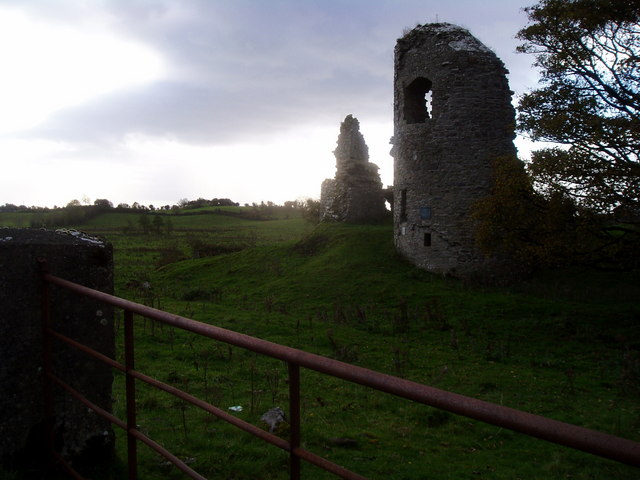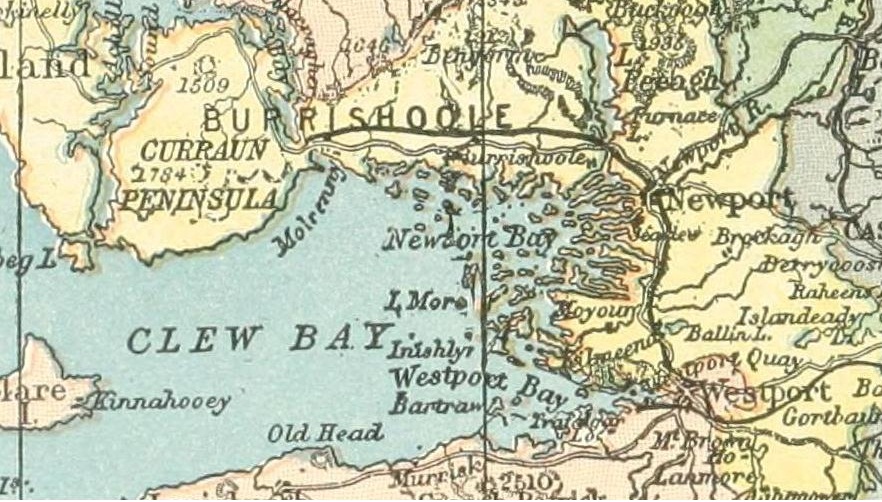|
Jordan D'Exeter
Jordan de Exeter (fl. 1239–58), also known as Jordan d'Exeter, was an Anglo-Norman knight, Sheriff of Connacht, and ancestor of the Clan Siurtain Gaileng/Mac Siurtain/Mac Jordan of Connacht. Life and family De Exeter took his family name from the town of Exeter in Devon, England but it is not known if he or previous members of the family were the first in Ireland. He appears to have participated in Richard Mor de Burgh's conquest of Connacht in 1230s. De Burgh granted the barony or cantred of Gallen to Hugh de Lacy, who transferred it to Jordan de Exeter, who was in possession of it by 1239. In 1250 Henry III gave him twenty-five marks yearly "in reward of services until he should be given waste lands worth £20 a year, which were given about the parish of Killallaghtan in Galway, to be held by the service of one knight." (p. 307) He built the castle of Ballylahan – now on the junction of the N58 and R321 in County Mayo. It overlooked Athlethan, or Strade, ... [...More Info...] [...Related Items...] OR: [Wikipedia] [Google] [Baidu] |
Floruit
''Floruit'' (; abbreviated fl. or occasionally flor.; from Latin for "they flourished") denotes a date or period during which a person was known to have been alive or active. In English, the unabbreviated word may also be used as a noun indicating the time when someone flourished. Etymology and use la, flōruit is the third-person singular perfect active indicative of the Latin verb ', ' "to bloom, flower, or flourish", from the noun ', ', "flower". Broadly, the term is employed in reference to the peak of activity for a person or movement. More specifically, it often is used in genealogy and historical writing when a person's birth or death dates are unknown, but some other evidence exists that indicates when they were alive. For example, if there are wills attested by John Jones in 1204, and 1229, and a record of his marriage in 1197, a record concerning him might be written as "John Jones (fl. 1197–1229)". The term is often used in art history when dating the career ... [...More Info...] [...Related Items...] OR: [Wikipedia] [Google] [Baidu] |
Dominican Order
The Order of Preachers ( la, Ordo Praedicatorum) abbreviated OP, also known as the Dominicans, is a Catholic mendicant order of Pontifical Right for men founded in Toulouse, France, by the Spanish priest, saint and mystic Dominic of Caleruega. It was approved by Pope Honorius III via the papal bull ''Religiosam vitam'' on 22 December 1216. Members of the order, who are referred to as ''Dominicans'', generally carry the letters ''OP'' after their names, standing for ''Ordinis Praedicatorum'', meaning ''of the Order of Preachers''. Membership in the order includes friars, nuns, active sisters, and lay or secular Dominicans (formerly known as tertiaries). More recently there has been a growing number of associates of the religious sisters who are unrelated to the tertiaries. Founded to preach the Gospel and to oppose heresy, the teaching activity of the order and its scholastic organisation placed the Preachers in the forefront of the intellectual life of the Middle Ag ... [...More Info...] [...Related Items...] OR: [Wikipedia] [Google] [Baidu] |
Clew Bay
Clew Bay (; ga, Cuan Mó) is a natural ocean bay in County Mayo, Republic of Ireland. It contains Ireland's best example of sunken drumlins. The bay is overlooked by Croagh Patrick to the south and the Nephin Range mountains of North Mayo. Clare Island guards the entrance of the bay. From the southwest part of the bay eastwards are Louisburgh, Lecanvey, Murrisk, and Westport; north of Westport is Newport, and westwards from there lies Mulranny, gateway to Achill. From the south side of the bay, between Clare Island and Achill, Bills Rocks can be seen. History The bay was anciently known in Irish as ''Cuan Mod'' 'h''("Mod Harbour") or ''Modlind'' ("Mod Pool"), and was associated with the Fir Bolg. Some writers claim that this name derives from Modh, one of the Tuatha Dé Danann. Another possibility is the Old Irish ''mod'', ''moth'', which meant "penis"; it is possible that the bay was imagined as a penis thrusting into the land. Another old name is ''Cuan Umaill'' ("h ... [...More Info...] [...Related Items...] OR: [Wikipedia] [Google] [Baidu] |
Carra, County Mayo
Carra () is one of the nine baronies of County Mayo in Ireland, located in the mid-south area of the county. It is sometimes known as Burriscarra. It incorporates the town of Castlebar, the villages of Tourmakeady, Belcarra and Turlough, where the National Museum of Country Life is situated. Cara covers an area from approximately Pontoon and Beltra Lough at its northern end to Partry (Ballyovey) near Ballinrobe and Tourmakeady at its southern end. History The ancient barony name is Conmhaícne Cúile Ceara. Clans in the barony include the Partraige and Conmaicne. O'Culachain (O'Colahan) was a sept of the Ui Fiachrach Muaidne (the Fir Ceara) and O'Gormog who once served as chiefs of the Ui Fiachrach. The Murrays, Ó Móráin, O'Learghusa and O'Tierney families were family clans of the barony of Carra. Carra can also refer to a small village located approximately two miles from Bonniconlon and eight miles from Ballina part of the Bonniconlon parish in the Achonry Diocese ... [...More Info...] [...Related Items...] OR: [Wikipedia] [Google] [Baidu] |
Galls Of Carra
Galls (from the Latin , 'oak-apple') or ''cecidia'' (from the Greek , anything gushing out) are a kind of swelling growth on the external tissues of plants, fungi, or animals. Plant galls are abnormal outgrowths of plant tissues, similar to benign tumors or warts in animals. They can be caused by various parasites, from viruses, fungi and bacteria, to other plants, insects and mites. Plant galls are often highly organized structures so that the cause of the gall can often be determined without the actual agent being identified. This applies particularly to some insect and mite plant galls. The study of plant galls is known as cecidology. In human pathology, a gall is a raised sore on the skin, usually caused by chafing or rubbing. Causes of plant galls Insects and mites Insect galls are the highly distinctive plant structures formed by some herbivorous insects as their own microhabitats. They are plant tissue which is controlled by the insect. Galls act as both the habitat ... [...More Info...] [...Related Items...] OR: [Wikipedia] [Google] [Baidu] |
Seneschal
The word ''seneschal'' () can have several different meanings, all of which reflect certain types of supervising or administering in a historic context. Most commonly, a seneschal was a senior position filled by a court appointment within a royal, ducal, or noble household during the Middle Ages and early Modern period – historically a steward or majordomo of a medieval great house. In a medieval royal household, a seneschal was in charge of domestic arrangements and the administration of servants, which, in the medieval period particularly, meant the seneschal might oversee hundreds of laborers, servants and their associated responsibilities, and have a great deal of power in the community, at a time when much of the local economy was often based on the wealth and responsibilities of such a household. A second meaning is more specific, and concerns the late medieval and early modern nation of France, wherein the seneschal (french: sénéchal) was also a royal officer in char ... [...More Info...] [...Related Items...] OR: [Wikipedia] [Google] [Baidu] |
Galway
Galway ( ; ga, Gaillimh, ) is a City status in Ireland, city in the West Region, Ireland, West of Ireland, in the Provinces of Ireland, province of Connacht, which is the county town of County Galway. It lies on the River Corrib between Lough Corrib and Galway Bay, and is the List of settlements on the island of Ireland by population, sixth most populous city on the island of Ireland and the List of urban areas in the Republic of Ireland by population, fourth most populous in the Republic of Ireland, with a population at the 2022 census of Ireland, 2022 census of 83,456. Located near an earlier settlement, Galway grew around a fortification built by the Kings of Connacht, King of Connacht in 1124. A municipal charter in 1484 allowed citizens of the by then walled city to form a Galway City Council, council and mayoralty. Controlled largely by a group of merchant families, the Tribes of Galway, the city grew into a trading port. Following a period of decline, as of the 21st ... [...More Info...] [...Related Items...] OR: [Wikipedia] [Google] [Baidu] |
Osraige
Osraige (Old Irish) or Osraighe (Classical Irish), Osraí (Modern Irish), anglicized as Ossory, was a medieval Irish kingdom comprising what is now County Kilkenny and western County Laois, corresponding to the Diocese of Ossory. The home of the Osraige people, it existed from around the first century until the Norman invasion of Ireland in the 12th century. It was ruled by the Dál Birn dynasty, whose medieval descendants assumed the surname Mac Giolla Phádraig. According to tradition, Osraige was founded by Óengus Osrithe in the 1st century and was originally within the province of Leinster. In the 5th century, the Corcu Loígde of Munster displaced the Dál Birn and brought Osraige under Munster's direct control. The Dál Birn returned to power in the 7th century, though Osraige remained nominally part of Munster until 859, when it achieved formal independence under the powerful king Cerball mac Dúnlainge. Osraige's rulers remained major players in Irish politics for th ... [...More Info...] [...Related Items...] OR: [Wikipedia] [Google] [Baidu] |
Annals Of Connacht
The ''Annals of Connacht'' (), covering the years 1224 to 1544, are drawn from a manuscript compiled in the 15th and 16th centuries by at least three scribes, all believed to be members of the Clan Ó Duibhgeannáin. The early sections, commencing with the death of King Cathal Crobdearg Ua Conchobair of Connacht, are exceptionally detailed and give a good account of Connacht affairs during the 13th and early to mid-14th century, particularly for the families of O'Conor and Burke. The accounts however become more desultory, especially for the 16th century. Nevertheless, it is an invaluable document relating much that would have otherwise remained utterly obscure or unknown in the history of Connacht, and Ireland in general. A comparison between it and the ''Annals of Clonmacnoise'' reveal a common source, or perhaps one is a partial copy of the other. See also * Irish annals References * ''Oxford Concise Companion to Irish Literature'', Robert Welsh, 1996. External links The A ... [...More Info...] [...Related Items...] OR: [Wikipedia] [Google] [Baidu] |
Jordan Óge De Exeter
Jordan Óge de Exeter (floruit, fl. 1269–1319) was an Anglo-Irish knight and Sheriff of Connacht. The younger son of Jordan de Exeter and Basilia de Bermingham, Jordan Óge first came to notice as Sheriff of Connacht in 1269 in Ireland, 1269, a post he held again in 1279. In 1280 he was Constable of Roscommon castle. Possessed of the cantred of Erris in Connacht, in the 1290s he held the barony of Athmethan, Waterford, from the King at a rent of £20 13s 4d. His first wife was Ismania, fl. 1302, "who seems to have been the heiress of a Christophre. Their son Jordan Bacach seems to have claimed lands in County Cork, Cork through Ismania [he] does not appear in Connacht history. It may be inferred that he succeeded to his father's Munster estates, and John to the Connacht estates." Jordan Óge became the heir of his nephew, Miler Fitz Miler de Exeter, upon the latter's death in 1317. He had two sons, John na Conairte de Exeter - described as the lord of Athelethan in 1335 and Jor ... [...More Info...] [...Related Items...] OR: [Wikipedia] [Google] [Baidu] |





